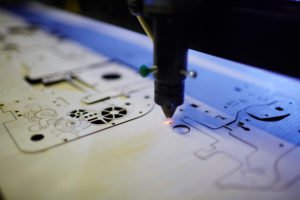What are the advantages of laser cutting wood?
Laser cutting wood is a highly precise and versatile method that offers several advantages for various applications.
Whether you’re working on intricate art pieces or precision engineering parts, laser cutting wood can provide numerous benefits:

- Precision and Accuracy: Laser cutting offers exceptional precision and accuracy, enabling intricate and detailed designs with tight tolerances. It cuts with a beam width as narrow as 0.1mm, allowing for fine, intricate cuts and detailed engraving.
- Clean Cuts: Laser cutting wood produces clean edges with minimal charring or burning, resulting in a finished product that often requires little to no post-processing. This is especially important for intricate designs and delicate materials.
- Versatility: Laser cutting machines can handle a wide range of wood materials, from hardwoods like oak and walnut to softer woods like pine and plywood. They can also cut through various thicknesses of wood, making them suitable for a broad spectrum of projects.
- Speed and Efficiency: Laser cutting is a fast and efficient process, with cutting speeds that can be adjusted to meet specific project requirements. It can significantly reduce production time, making it cost-effective for both prototyping and production runs.
- Minimal Material Waste: Laser cutting minimizes material waste because the cutting path is highly optimized. This is particularly advantageous when working with expensive or rare wood species.
- Intricate Shapes and Patterns: Laser cutting allows for the creation of complex shapes, patterns, and geometries that would be challenging or impossible to achieve with traditional woodworking tools. This makes it ideal for artistic and decorative projects.
- Repeatability: Laser cutting is highly repeatable, ensuring consistent results for batch production and maintaining design integrity across multiple pieces.
- Engraving and Marking: In addition to cutting, laser machines can engrave wood, adding custom designs, text, or logos to the surface. This feature is valuable for personalization and branding purposes.
- Non-contact Process: Laser cutting is a non-contact process, meaning the laser beam doesn’t physically touch the wood. This eliminates the risk of tool wear and tear, reducing maintenance costs.
- Digital Design Integration: Laser cutting can seamlessly integrate with computer-aided design (CAD) and computer-aided manufacturing (CAM) software, allowing for precise control and customization of designs. Designs can be adjusted and modified digitally, enhancing flexibility and adaptability.
- Prototyping and Iteration: Laser cutting is particularly useful for rapid prototyping. It allows designers and engineers to quickly create prototypes and iterate on designs before committing to final production.
- Low Heat Generation: Laser cutting generates minimal heat during the cutting process, reducing the risk of warping or distorting the wood material. This is especially important when working with delicate or thin wood.
- No Tool Changes: Unlike traditional woodworking methods, laser cutting does not require tool changes for different cutting profiles or shapes, saving time and effort.



While laser cutting wood offers numerous advantages, it’s essential to note that the suitability of this method depends on the specific project, wood type, and desired finish. Additionally, safety precautions, such as proper ventilation and eye protection, must be observed when using laser cutting machines due to the emission of fumes and the intensity of the laser beam.





